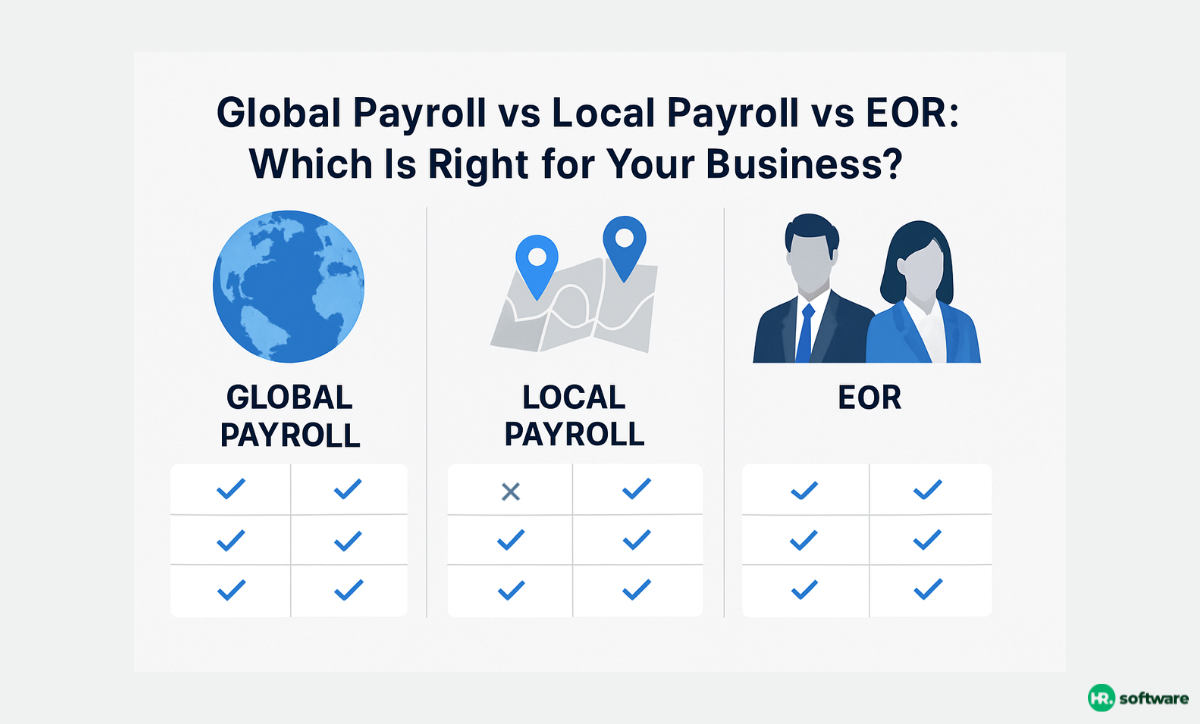.svg)

.svg)
.svg)
.svg)
.svg)
.svg)
.svg)
.svg)
.svg)



Global payroll is a unified system for managing payroll across multiple countries through a single provider. Instead of working with separate vendors in every country, global payroll consolidates payroll data into one platform for easier reporting and oversight.
How it Works: A global payroll provider connects local payroll processes in each country into one centralized system. It manages multi-currency payments, ensures compliance with local tax rules, and provides dashboards for visibility. However, you must already own legal entities in the countries where employees are hired.
Pros: Scalable, efficient, and ideal for multinational enterprises with significant workforces.
Cons: Complex implementation, higher cost, requires local entities to operate.
Best For: Enterprises with existing global presence and legal entities seeking consolidation and transparency.
Local payroll is when payroll is managed within a single country, either by an in-house HR team or a local provider. Each country operates independently, with its own systems, compliance requirements, and payroll cycles.
How it Works: Payroll is processed locally for each country where the business operates. This may involve multiple providers, local tax authorities, and native banking integrations. While compliant, this results in fragmented reporting.
Pros: High compliance accuracy at the country level, straightforward for small-scale operations, and cost-effective for single-country presence.
Cons: Difficult to scale across multiple regions, inconsistent employee experience, and fragmented payroll data.
Best For: Companies with operations in only one or a few countries, or those prioritizing deep compliance in limited regions.
An Employer of Record (EOR) is a third-party provider that legally employs workers on behalf of a client in countries where the client has no legal entity. This allows companies to expand globally without establishing subsidiaries or local offices.
How it Works: The EOR becomes the official employer in the target country. It manages payroll, benefits, tax compliance, and employment contracts, while the client controls daily work. EORs also handle contractor payments and mitigate risks of misclassification.
Pros: Enables fast entry into new markets, eliminates the need for entity setup, and lowers compliance risk.
Cons: Higher per-employee costs, less direct control over employment contracts.
Best For: Startups, remote-first companies, or enterprises testing new markets before committing to full entity setup.
Choosing between global payroll, local payroll, and EOR depends on coverage, compliance needs, scalability, cost, and employee experience.
There is no one-size-fits-all payroll model. The right choice depends on your current operations and future expansion goals. Startups may need speed and flexibility, while enterprises require scale and consolidation.
Risk-averse firms: Prioritize EOR or global payroll providers with strong compliance records.
Global Payroll, Local Payroll, and EOR each offer distinct advantages. The right model depends on your company’s size, compliance risk tolerance, expansion speed, and existing global footprint. Local payroll works for single-country operations, global payroll fits enterprises with entities, and EOR is best for startups and fast expansion. Evaluate your business goals and resources before choosing a payroll strategy.
Do I need a legal entity to use Global Payroll?
Yes, global payroll providers require you to have entities in each country.
Is EOR more expensive than payroll outsourcing?
EOR typically has higher per-employee costs but avoids the major expense of setting up entities.
When should a company switch from EOR to global payroll?
Switch when your employee headcount in a country justifies creating a local entity for cost efficiency.
Can I combine local payroll and EOR in different countries?
Yes, many companies use hybrid approaches depending on market maturity.
Which is better for startups: local payroll or EOR?
EOR is usually better, as it enables quick hiring in multiple countries without legal complexity.